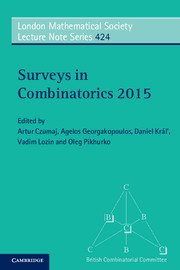Book contents
- Frontmatter
- Contents
- Preface
- 1 Ramsey classes: examples and constructions
- 2 Recent developments in graph Ramsey theory
- 3 Controllability and matchings in random bipartite graphs
- 4 Some old and new problems in combinatorial geometry I: around Borsuk's problem
- 5 Randomly generated groups
- 6 Curves over finite fields and linear recurring sequences
- 7 New tools and results in graph minor structure theory
- 8 Well quasi-order in combinatorics: embeddings and homomorphisms
- 9 Constructions of block codes from algebraic curves over finite fields
- References
4 - Some old and new problems in combinatorial geometry I: around Borsuk's problem
Published online by Cambridge University Press: 05 July 2015
- Frontmatter
- Contents
- Preface
- 1 Ramsey classes: examples and constructions
- 2 Recent developments in graph Ramsey theory
- 3 Controllability and matchings in random bipartite graphs
- 4 Some old and new problems in combinatorial geometry I: around Borsuk's problem
- 5 Randomly generated groups
- 6 Curves over finite fields and linear recurring sequences
- 7 New tools and results in graph minor structure theory
- 8 Well quasi-order in combinatorics: embeddings and homomorphisms
- 9 Constructions of block codes from algebraic curves over finite fields
- References
Summary
Abstract
Borsuk [16] asked in 1933 if every set of diameter 1 in Rd can be covered by d + 1 sets of smaller diameter. In 1993, a negative solution, based on a theorem by Frankl and Wilson [42], was given by Kahn and Kalai [65]. In this paper I will present questions related to Borsuk's problem.
1 Introduction
The title of this paper is borrowed from Paul Erdős who used it (or a similar title) in many lectures and papers, e.g., [39]. I will describe several open problems in the interface between combinatorics and geometry, mainly convex geometry. In this part, I describe and pose questions related to the Borsuk conjecture. The selection of problems is based on my own idiosyncratic tastes. For a fuller picture, the reader is advised to read the review papers on Borsuk's problem and related questions by Raigorodskii [105, 106, 107, 110, 112]. Among other excellent sources are [13, 14, 18, 89, 99].
Karol Borsuk [16] asked in 1933 if every set of diameter 1 in Rd can be covered by d + 1 sets of smaller diameter. That the answer is positive was widely believed and referred to as the Borsuk conjecture. However, some people, including Rogers, Danzer, and Erdős, suggested that a counterexample might be obtained from some clever combinatorial configuration. In hindsight, the problem is related to several questions that Erdős asked and its solution was a great triumph for Erdősian mathematics.
2 Better lower bounds to Borsuk's problem
The asymptotics
Let f(d) be the smallest integer such that every set of diameter one in Rd can be covered by f(d) sets of smaller diameter. The set of vertices of a regular simplex of diameter one demonstrates that f(d) ≥ d + 1. The famous Borsuk–Ulam theorem [16] asserts that the d-dimensional ball of diameter 1 cannot be covered by d sets of smaller diameter.
- Type
- Chapter
- Information
- Surveys in Combinatorics 2015 , pp. 147 - 174Publisher: Cambridge University PressPrint publication year: 2015
References
- 5
- Cited by

